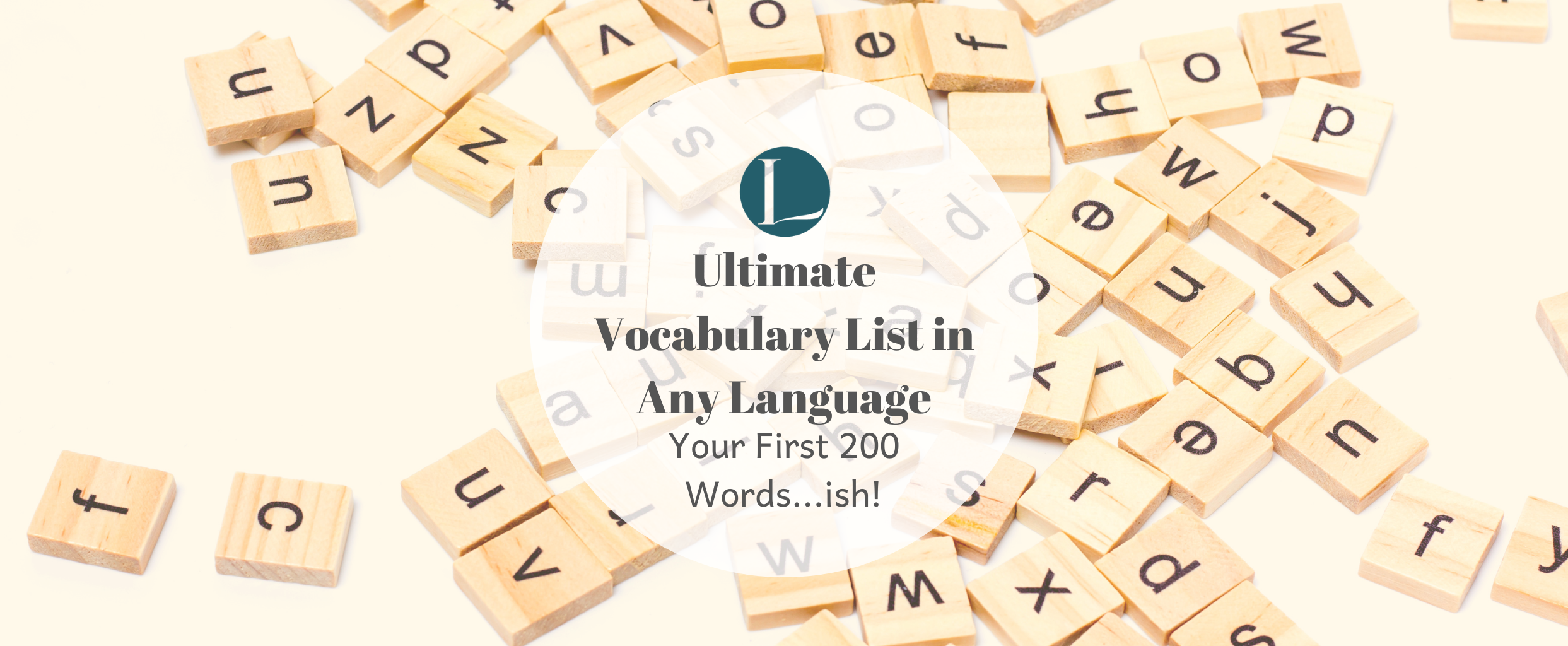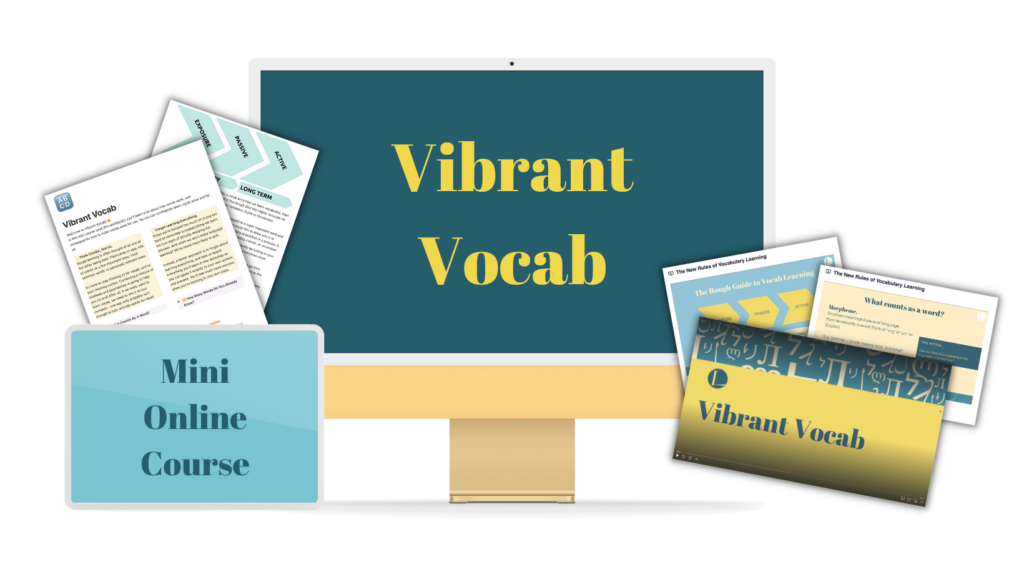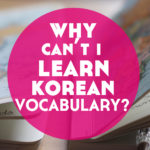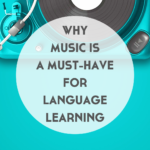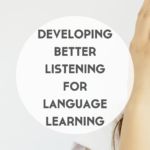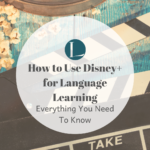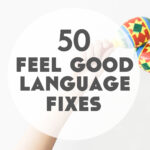January 10th, 2020
Ultimate Vocabulary List You Need In Any Language
Here’s your ultimate vocabulary list you need in any language. This isn’t a long list. Instead, it’s the essential vocab to get you started – roughly your first 200 words. Enjoy!
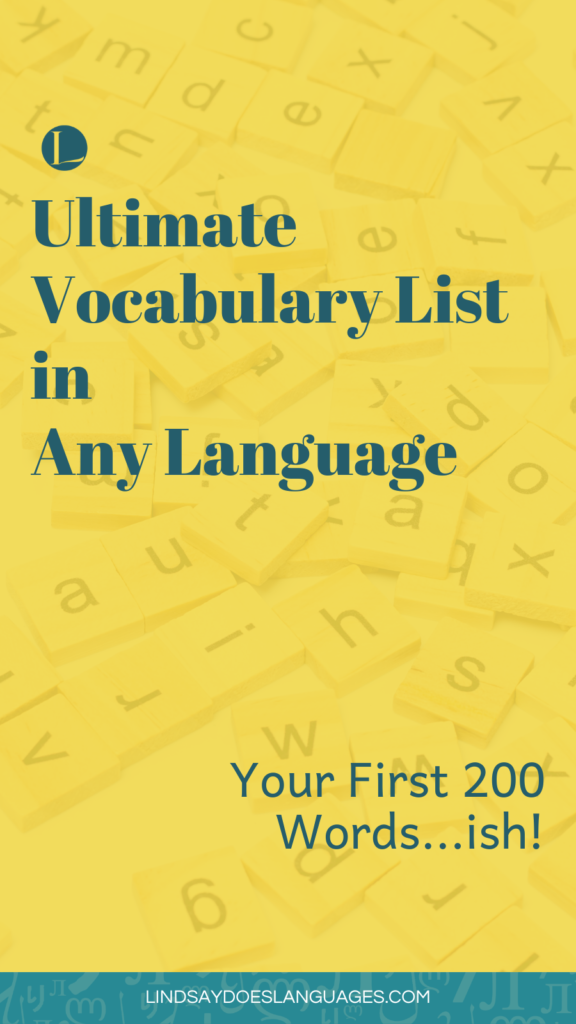
One of the most important things when you learn a new language is knowing where to start. It can be really overwhelming trying to decide which resource is right for you. So do it on your own terms instead and use the essential vocabulary to learn in any language list in this article to get you started.
I’ve studied many languages now to various levels, but the stage I love most is being a beginner.
It’s as if each time is a chance to do better than before, and make better choices to learn more useful stuff from the get go.
Perhaps you’re reading this slightly doubtful, thinking “surely the most essential vocabulary to learn in any language is introductions, the weather, the this, the that…etc…!”. And that’s fine, we all have our own ideas, and I’ve left space throughout the list to add in your own relevant words and phrases that matter most to you too.
However, I don’t find myself very often encountering people who speak another language and instantly saying “Hello my name is Lindsay and I live in England and I am from England and good morning and good afternoon.”
With that in mind, here’s the list of essential vocabulary to learn in any language in a logical order. We’ll start first with essential vocabulary to learn in any language for travel, then go onto beginner stuff.
If you’re looking for techniques with what to actually do with these words and how to learn vocabulary in any language, read this article after you’ve finished here!
Ultimate Vocabulary List You Need In Any Language
The list is broken down into simple groups, starting with the essentials for short term travel.
Ultimate Vocabulary List: For Short Term Travel
At the Bare Minimum
Hello
Thank you
Goodbye
Please
Yes
No
Maybe
What you can already do with this:
Basic politeness. I mean, you could smile and wave but it’s nicer if you can open your mouth as well, right?
Thank the air steward, the immigration officer, the bus driver, the hotel staff, the restaurant staff…
Greet the air steward, the immigration officer, the bus driver, the hotel staff, the restaurant staff…
Say hello back when strangers say hello. Ignore everything your parents taught you as a child about talking to strangers. (But, you know, be cautious. Obviously.)
Say ‘no thank you’ when people try and sell you something you don’t want.
Say ‘yes please’ when people try and sell you something you do want.
Related: How to Learn a Language for Holidays and Travel
Ok, I’m in! What next?!
One
Two
How much?
Other necessary number words for currency (are we talking hundreds of Bulgarian Lev, thousands of Vietnamese Dong or tens of thousands of South Korean Won? And what’s the word for the currency – Lev and pennies, Dong and cents? Hmm, don’t think so. Find out how to say these bits too.)
What you can do now:
Order food and tickets with basic request and point, nod and smile (and a verbal thank you, of course! Go us!)
Ask for prices and hopefully understand the answer!
Something worth thinking of here – if you ask for the price in the language and don’t understand the response, have a notebook in your pocket ready to ask to see it written.
Related: How to Overcome Shyness When Speaking a Foreign Language
Gimme more like the Britney Spears song!
What is this?
Do you have…? / Is there…?
I go/am going…
I need…
I want…/I would like…
Ok. You can do a lot more stuff now:
Ask what is in the food you see. Helpful to avoid any deadly allergic reactions. I could be saving a life here. You’re welcome.
Ask for the names if things in the language you’re learning. You may have picked up the word for the language name by now, so can expand on “What is this?” with a “English – mushroom. Korean…?” Cue inflection tone.
Start to form slightly longer sentences. For example, we can already master the majestic sentence that is…”I would like one please”. Go us!
Tell people your basic needs with a little miming. For example, if you’re thirsty say “I want” and mime drinking, or if you’re lost say “I go” and point to a place on a map then shrug at who you’re speaking to.
Related: How to Start Speaking a New Language For The First Time
I tell you what I want (what I really really want)
Ticket
Menu
Reservation
Any personal vocab you need, eg, medicine names, food or allergy names, places you know you’re going
Any other key things you’re likely to want, need, or go to (and this is the key bit when you’re learning just for a short travel trip) that you can’t mime easily.
What you can do now:
Extent your sentences into full ones. Rather than “I want two please”, you can now say “I want two tickets please”.
Related: Guest Post: Speed Up Vocabulary Learning – 2 Self-Study Techniques You Can Start Today
Ultimate Vocabulary List: Real Conversation Starters
It’s…isn’t it?
Is it…?
It’s…
It’s not…
Hot
Cold
Good
Alright
Pretty
Spicy
Tasty
What you can do now:
Start a conversation with a stranger and not look like a weirdo! No more going up to people you don’t know like “Hello my name is Lindsay and I live in England and I am from England and good morning and good afternoon.” Hooray!
Ask basic questions.
Make a basic sentence.
Make a basic sentence negative.
Describe stuff you encounter.
Related: How to Make the Most of Travel for Language Learning
Ultimate Vocabulary List: For Beginner Language Learners
If you’re not planning a trip just yet (or even if you are and want to learn more of the language) here’s what’s going to actually help you when you start to learn a language. Leave all animals and colours at the door.
Firstly, it can be useful to use the above as an introductory guidelines, but just in case you don’t want to do that, let’s imagine we’re starting from scratch here. We’ll start again with ‘hello’.
Being Polite
One-size-fits-all greeting for meeting (hello). – Note here, some languages have different greetings for times of day, number of people you’re greeting, gender of you, gender of who you’re greeting, formality. Keep it as simple as possible to begin with and stick with one as far as possible. Yes, I know it’s not always possible.
One-size-fits-all…un-greeting? A word for goodbye. – Note here exactly the same things as for the one-size-fits-all greeting for meeting. Also, some languages have different words for goodbye depending on if you’re the one leaving or staying. Again, not always super easy. Keep it as simple as possible for yourself as a beginner.
One-size-fits-all “how are you?” – Same as above – formal/informal, singular/plural etc. Do your best.
Response to “how are you?” – Is it customary to ask back? Should you be honest in this language or always say “fine, ta.”?
Something like “pleased to meet you”. – Depending on the language, this could be very long and confused or not even typically said. Many languages have some equivalent here though.
Please – Maybe multiple options depending on what you’re asking, maybe never said. Either way, figure it out.
Thank you – Keep it simple for your brain that’s potentially already swelling if you’ve got a language with 17 ways to say hello that you can’t avoid learning.
Related: How to Learn a Language After Moving to Another Country
Essential Verb Stuff
I have
I am
I do
I want
I need
I go
I eat
I drink
I know
I speak
I listen
I read
I write
I give
I think
I like
I understand
It is
There are
How to make a question – What about when you want to ask someone if they have, know, think, like something? In some languages this is super easy and you can just raise your voice at the end of the sentence. Other times, you’ll have a little more work to do. It’s worth checking in to learn how.
How to make it negative – Sometimes this will be easy and sometimes…well, not so easy. If you start to research how negative sentences work and it looks complicated for a newbie, just learn the word “no” and emphasise this before (and maybe after as well) you say the present tense.
Easiest way to put it in the past – You don’t need to overcomplicate things with learning multiple verb tenses and conjugations if that’s how the language you’re learning does things. Instead, focus to begin with on learning “past” and gesture towards the past with your hands as you say a present tense verb. When you learn how to say things like “yesterday” or “last year”, you can use these phrases to be more precise.
Easiest way to put it in the future – Same again. You don’t need to learn a whole new tense and set of verb conjugations here. If it looks tricky, just learn the word for “future” to start you off, and combine the present tense verb above with “future” and a point forward.
Other people (you, he, she, it, we, they) – Some languages have different words here for singular/plural, formal/informal, inclusive/exclusive etc. To keep it as easy as possible, what you want to be Googling for is “subject pronouns” plus the name of the language you’re learning. Another thing to note is that some languages don’t need you to use the ‘subject pronoun’ with each verb as the verb changes for different people/subject pronouns, so shows who’s being talked about in the verb itself.
What you can say now…
You can often blag it if you don’t know a noun. They tend to be easier to mime. Verbs…hmm…not always so easy. It’s worth learning a few key verbs so you can get across what you want to do, and then mime the details (aka the nouns).
Related: All The Language Learning Listening Resources That You’ll Ever Need
Essential Adjectives
Good
Bad
Nice
Big
Small
Hot
Cold
Pretty/Beautiful (to describe stuff and places, not people…)
Important
Interesting
Boring
Easy
Difficult
Different
Spicy
Tasty
Free
Cheap
Expensive
Near
Far
Early
Late
How to say: “it is ADJECTIVE.”
How to say: “is it ADJECTIVE?”
How to say: “it’s ADJECTIVE, isn’t it?”
How to say: “it’s not ADJECTIVE.”
Learn if these can be used in simple exclamations, such as in Spanish with “¡Qué ADJECTIVE!” (or if you’d just say “it’s ADJECTIVE”, which you’ve already learnt. Legend.)
Any other adjectives relevant to you, your interests, and what you’re likely to encounter when using the language.
What you can say now…
You can use those verbs with your adjectives to combine into really basic “semi” sentences. Someone points to the soup you’re eating, you can say “Tasty! I think tasty!” or “It’s not cold…it’s hot!”
Next, we’ll learn some useful words to help expand that even further.
Related: 4 Essential Mindset Shifts for Language Learning
Essential Little Useful Words
Too
Very/Really/So
Enough
And
But
So/Therefore
Because
With
Lots/a lot of/many
Few/not many
Today
Yesterday
Tomorrow
Now
Soon
Before/ago
During
After/later
Always
Often
Usually
Sometimes
Rarely
Only
To
From
With
Better (than)
Best
How to make any adjective into it’s comparative and superlative cousin – eg good, better, best but important, more important, the most important.
Basic numbers. 1-10 essential, 0 is handy, going up from 11-20 and then learning the pattern (if there is one) is best, then 100, 1000 and higher if relevant for currency.
What you can say now…
A lot. Really expand on what you can do already. For example, you can now say “it’s too hot” or “is it always cold?”
Many of these words will get their meaning across if you use them on their own too, which is handy.
Related: How to Become a Better Language Learner
Exclamations
Seriously?
No problem!
Wait!
Exactly!
Of course!
I agree!
Never mind.
That’s great/wonderful/amazing!
What a pity/shame!
May I?
What You Can Do Now:
Easily respond, even when you’re not quite sure of the full sentence to answer with.
Make more meaningful friendships and relationships with people when speaking your target language.
Related: 5 Tips to Build a Language Learning Habit
Questions
Where?
When?
Who?
What?
Why?
Which?
How?
How much?
How many?
Do you speak…?
How do you say…in…?
Can you repeat please?
Can you speak more slowly please?
What You Can Do Now:
Begin to combine what you already know into questions. The nouns in the next section will help here too.
Ask questions to keep conversations flowing.
Related: The Ultimate Guide to Netflix for Language Learning
Essential Nouns
THING – single-handedly the most important noun you’ll every learn…it can replace literally any noun word you don’t know!
Time
Minute
Hour
Day
Morning
Afternoon
Evening
Night
Week
Month
Year
Months of the year and days of the week. Learn how to tell the time when you’re ready (it can be a pain), besides there’s digital clocks everywhere now!
Home
Town
City
Country
World
Any relevant place names that are different to how they’re said in your native language.
Place
Room
School
Work
Other relevant places to you. For example, if you work in a hospital, ‘hospital’ is a good word to learn. Probably also a good one to learn if you’re prone to falling over.
Person
Man
Woman
Child
Family
Relevant family words. Typically, you’d expect mum, dad, brother sister and co to make the list, but I think when it comes to family vocab, it can be really personal. What if you’re adopted or you have a step-dad or a half-sister? Start by learning the family vocab that’s relevant to you and fill in the blanks of the others as you go.
Part
Problem
Question
Life
With these, you can combine what you know already to describe your life (or part of it), say “no problem!” or yell out loud when there is one, and lean in and say “I have a question” before asking it. Just like the monocle emoji would do if it were human.
Book
Money
Water
Don’t go overboard with the basic nouns like these, but learn some key ones that you see popping up in frequent vocab lists for the language you’re learning.
What You Can Do Now:
Put your newfound nouns together with everything in the list so far to start structuring better short sentences. Woohoo!
Related: All The Writing Resources for Language Learning That You’ll Ever Need
Remember Vocabulary Once and For All
Do you struggle with remembering the most important vocab in the language you’re learning?
Ever tried to start with a blank canvas on a new app and ended up overwhelmed with how many words ‘need review’?
Wondering if stacks of notebooks with the same words written again and again is the only way?
This is exactly why I made Vibrant Vocab. You’ll learn…
How words work. And how to use this to help you learn words.
The biggest thing you can do to instantly help you remember words. And all the different ways that can be applied for your way of learning.
The essential words to learn first that let you say what you want to say. So you can communicate without waiting to learn aaaaalll the words.
Ready to remember words once and for all?

